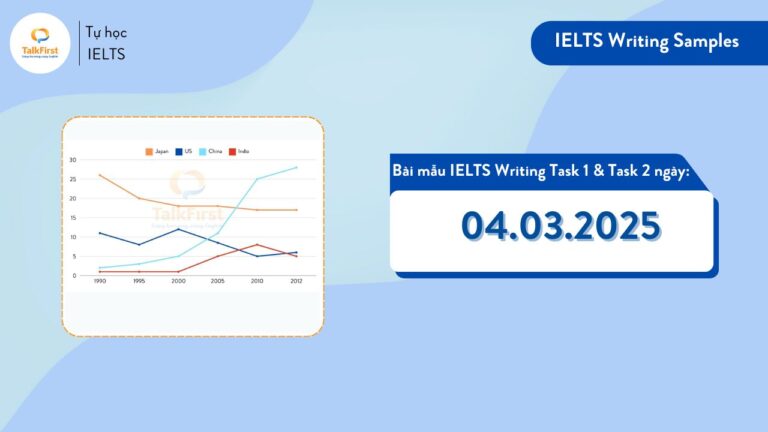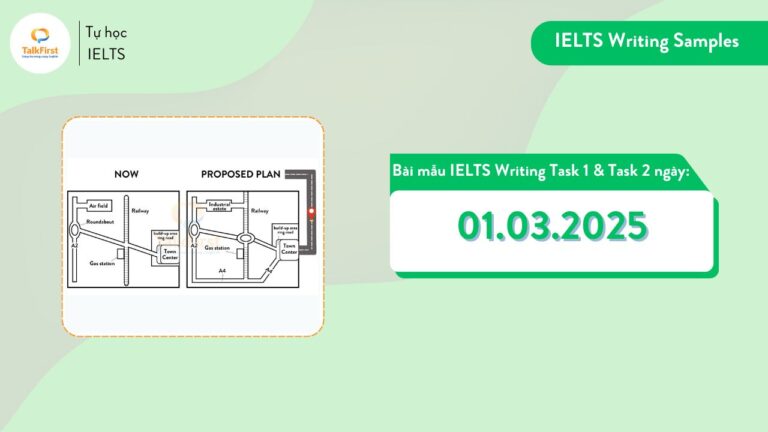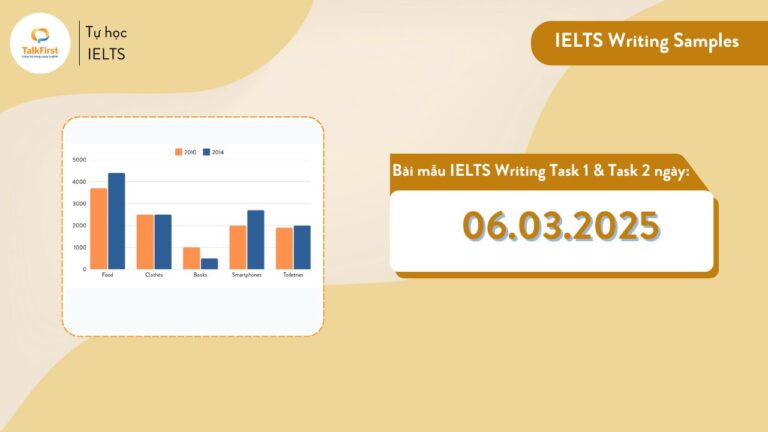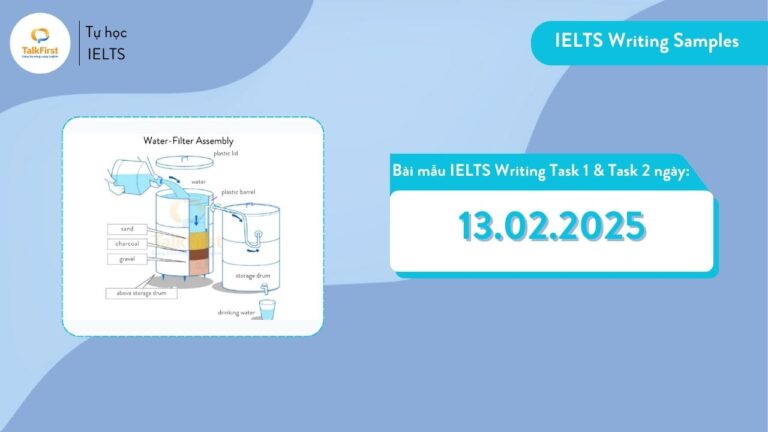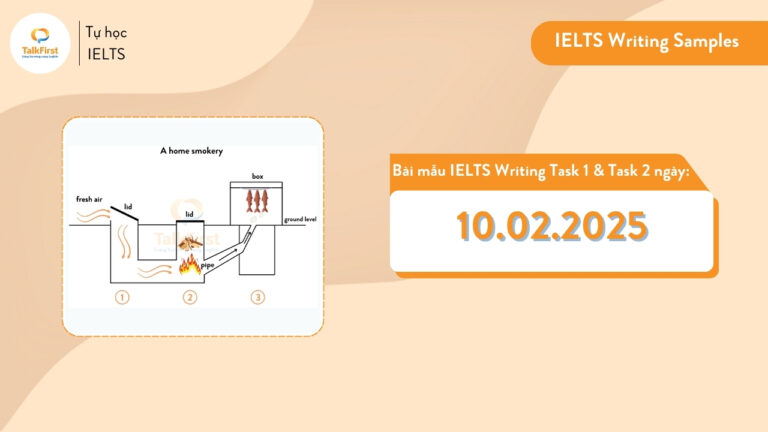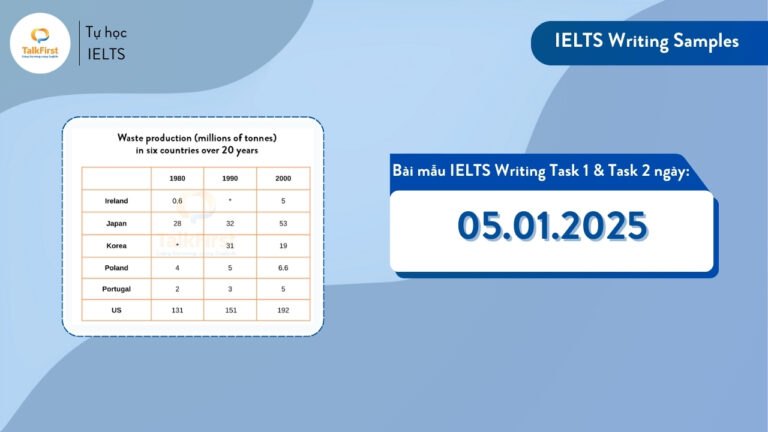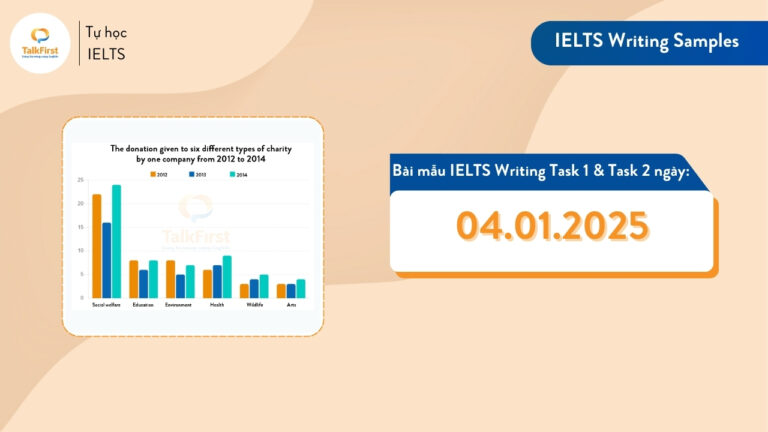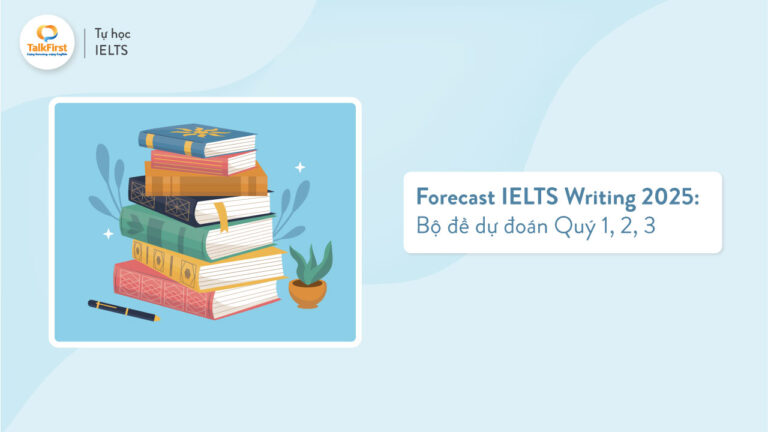Đề thi IELTS Writing Task 2 ngày 29/05 vừa qua lại là một câu hỏi dạng Agree – Disagree, một dạng câu hỏi đang rất được ưa chuộng trong thời gian gần đây. Một bài IELTS Writing Task 2 topic về việc sử dụng điện thoại di động (mobile phones) – hành vi cực kỳ phổ biến trong đời sống ngày nay, và có lẽ ai trong chúng ta cũng đều sử dụng thiết bị này trong sinh hoạt hằng ngày.
Cùng tham khảo bài IELTS Writing Task 2 sample sau đây được biên soạn chi tiết bởi đội ngũ chuyên gia học thuật band 8.0+ tại TalkFirst và note lại những từ vựng quan trọng!

1. Phân tích cơ bản và cấu trúc bài viết
| Some people think that mobile phones should be banned in public places like libraries, shops and on public transport. To what extent do you agree or disagree with this statement? |
1.1. Phân tích cơ bản
Lưu ý: Đề bài này đang tập trung hỏi về việc có nên cấm (ban) sử dụng điện thoại ở những nơi công cộng (public places) như thư viện (libraries), cửa hàng (shops) và trên các phương tiện giao thông công cộng (public transport) hay không. Chúng ta có thể brainstorm một số luận điểm nhằm ủng hộ/phản đối quan điểm này.
Lý do NÊN cấm sử dụng điện thoại di động ở nơi công cộng:
- Phones can be annoying in places like libraries, where people are supposed to keep silent and concentrate.
- People can be busy sending messages and making phone calls instead of talking with people around them, for example in a shop when they are being served.
- Mobile phones can be used to take photos of other people in public places without their permission.
Lý do KHÔNG NÊN cấm sử dụng điện thoại di động ở nơi công cộng:
- Mobiles do not need to be intrusive (uninvited noise to others) as they can easily be turned into silent or vibrate mode.
- Phones can be useful in case of emergencies, for instance, accidents in public places.
- Phones can provide entertainment when traveling on tedious journeys, particularly on public transport.
Sau khi đã có nhiều ý tưởng, chúng ta chỉ cần chọn trong số những ý trên để viết thành bài essay hoàn chỉnh. Nhưng trước tiên, dàn ý cần được soạn ra để lên kế hoạch cho bài viết chỉn chu hơn!
1.2. Cấu trúc bài viết
- Introduction:
– Paraphrase lại câu hỏi đề bài.
– Đưa ra quan điểm cá nhân: Không đồng tình. Không nên cấm sử dụng hoàn toàn vì chúng vẫn có ích nếu sử dụng hợp lý.
- Body paragraph 1:
Có lý do để cấm sử dụng điện thoại di động ở nơi công cộng.
– (1) Phones can be annoying in places like libraries, where people are supposed to keep silent and concentrate.
– (2) Mobile phones can be used to take photos of other people in public places without their permission.
- Body paragraph 2:
Tuy nhiên, nếu sử dụng hợp lý, điện thoại di động vẫn có những lợi ích rõ ràng.
– (1) Mobiles do not need to be intrusive (uninvited noise to others) as they can easily be turned to silent or vibrate mode.
– (2) Phones can be useful in case of emergencies, for instance, accidents in public places.
– (3) Phones can provide entertainment when traveling on tedious journeys, particularly on public transport.
- Conclusion:
– Không nên cấm sử dụng điện thoại di động ở nơi công cộng. Thay vào đó, thay đổi cách sử dụng điện thoại di động là biện pháp thiết thực hơn.
2. Sample Answer band 8.0+
Some people opine that the use of cell phones in public places such as libraries, shops, and public vehicles should be prohibited as it causes great annoyance to other people. Personally, I disagree with this point of view as I believe that with proper use, mobiles are still helpful.
On the one hand, it is true that mobile phones can be intrusive in public areas. For example, in places like libraries, where people are supposed to keep silent and concentrate on their books or reading materials, a mobile ringtone or a phone conversation can totally divert their attention, thereby disrupting the ideal work environment. Besides, mobile phones can be used to take photos of other people without their permission. On public means of transport like a bus, for instance, one can easily snap a photo of others without them even knowing. This not only invades their personal privacy but can also lead to potential risks, such as someone’s pictures being sold for commercial purposes or even other negative intentions.
On the other hand, despite the aforementioned disadvantages, mobile phones are useful in a number of ways. First and foremost, these devices are not necessarily synonymous with irritation since they can easily be turned into silent or vibrate mode. Furthermore, they are a real help in many adverse circumstances in public places. In case of emergencies, for example, a road accident, residents will have certain difficulties calling for the ambulance without phones. Additionally, when connected to the Internet via WiFi or 3G, these technological gadgets are a cheap source of entertainment on the move, comforting people on tedious journeys or in anxious situations. Therefore, a ban on mobile phones will deprive people of the undeniable benefits these devices provide.
In conclusion, although mobile phones may cause disturbance for the public, I maintain that they are advantageous if used properly.
308 words – Band 8.0+ – Written by TalkFirst!
3. Các từ vựng cần highlight
- prohibit (V, B2): cấm (= ban)
- intrusive (Adj, C2): ồn ào, phiền toái
- divert one’s attention (V, C1): làm mất tập trung
- …, thereby + Ving: do đó
- invade (V, B2): gây ảnh hưởng tiêu cực
- aforementioned (Adj): nêu trên
- synonymous with (Adj, C2): đồng nghĩa với
- irritation (N, C2): sự khó chịu
- on the move (Phrase): trong khi di chuyển
- tedious journeys (Adj, C1): những chuyến đi nhàm chán
- a ban on (N): lệnh cấm
- deprive sb of sth (V, C1): ngăn cản
- disturbance (N, C1): sự cản trở, làm phiền
TalkFirst hy vọng rằng bài viết trên giúp ích bạn trong quá trình luyện thi IELTS, đặc biệt là kỹ năng Writing. Đừng quên đọc thêm các tài liệu và đề thi IELTS tại TalkFirst để chuẩn bị thật sẵn sàng cho kỳ thi bạn nhé. Chúc bạn ôn tập và cải thiện kết quả bài thi thật tốt!
Nếu bạn đang tìm kiếm khoá học luyện thi IELTS uy tín, tham khảo thêm Khóa học Luyện thi IELTS cam kết đầu ra tại Anh ngữ TalkFirst.



